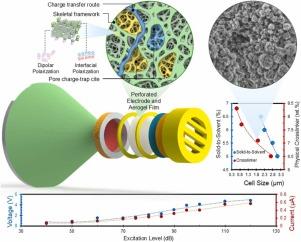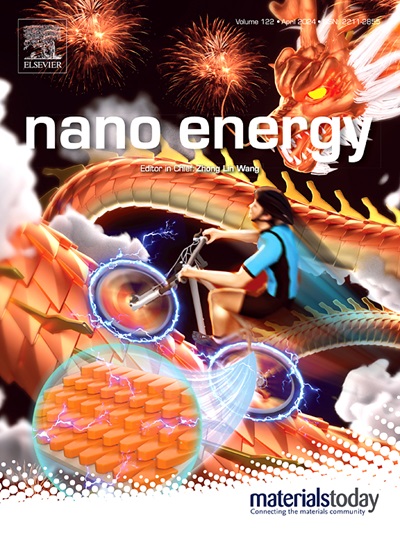Ultra-Lightweight Aerogel Composites for Sound-Driven Triboelectric Nanogenerator
IF 16.8
1区 材料科学
Q1 CHEMISTRY, PHYSICAL
引用次数: 0
Abstract
Recent advancements in multifunctional materials have underscored the importance of nanostructured porous aerogels in the development of high-performance triboelectric nanogenerators (TENGs) for diverse applications. The unique nanostructured assembly of aerogels integrates a substantial volume of air within the material, leading to ultra-low density and enhanced electrical insulation properties. In this study, we employed polyvinylidene fluoride (PVDF) and graphene nanoplatelet (GnP) to develop an aerogel with superior triboelectric performance. The abundant dipoles within the PVDF matrix, coupled with the conductive GnP nanoparticles and their interaction with the polymer chains, significantly improved charge transfer throughout the aerogel’s skeletal framework. This enhancement was reflected in the aerogel’s triboelectric performance, where it effectively powered capacitors representative of low-power electronics, achieving a peak power density of 307.5 mW/m2. By optimizing the polymer load and physical crosslinker via sol-gel processing, the mechanical cohesiveness and flexibility of the aerogel were enhanced. Leveraging its ultra-low density of 0.25 g/cm3, enhanced triboelectric performance, and mechanical flexibility, a Sound Aerogel-based Sensor TENG (SAS-TENG) was designed. The sensor demonstrated that acoustic stimuli within the 40 dB to 120 dB range provided sufficient force to mobilize the ultra-lightweight aerogel, thereby activating the contact-and-separation mode TENG. The voltage output ranged from 1.05 V to 4.85 V as the acoustic stimuli increased from 40 dB to 120 dB. The SAS-TENG exhibited an impressive specific power output of 15.37 mW/g, highlighting its potential for development of lightweight, self-powered sound sensors in IoT networks.

求助全文
约1分钟内获得全文
求助全文
来源期刊

Nano Energy
CHEMISTRY, PHYSICAL-NANOSCIENCE & NANOTECHNOLOGY
CiteScore
30.30
自引率
7.40%
发文量
1207
审稿时长
23 days
期刊介绍:
Nano Energy is a multidisciplinary, rapid-publication forum of original peer-reviewed contributions on the science and engineering of nanomaterials and nanodevices used in all forms of energy harvesting, conversion, storage, utilization and policy. Through its mixture of articles, reviews, communications, research news, and information on key developments, Nano Energy provides a comprehensive coverage of this exciting and dynamic field which joins nanoscience and nanotechnology with energy science. The journal is relevant to all those who are interested in nanomaterials solutions to the energy problem.
Nano Energy publishes original experimental and theoretical research on all aspects of energy-related research which utilizes nanomaterials and nanotechnology. Manuscripts of four types are considered: review articles which inform readers of the latest research and advances in energy science; rapid communications which feature exciting research breakthroughs in the field; full-length articles which report comprehensive research developments; and news and opinions which comment on topical issues or express views on the developments in related fields.
 求助内容:
求助内容: 应助结果提醒方式:
应助结果提醒方式:


